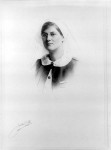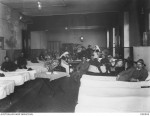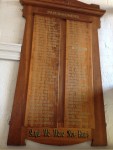THOMPSON, Muriel Edith Lucy
Muriel Edith Lucy Thompson (1889–1951)
Introduction
Muriel Edith Lucy Thompson is named on the Great War honour boards commemorating parishioners who served overseas between 1914 and 1918. Her connection with the parish was as much by family (she was related to the vicar) as by attendance.
Thompson served in Egypt, England France between 1915 and 1919. She was promoted to Sister in 1918 and mentioned in despatches for her work.
After living in her home town of Hobart in the 1920s, in 1929 she married the Reverend Joseph Auburn Reynolds. They lived in his parishes of Walgett then Bundarra in NSW until his death in 1946.
Muriel Reynolds (Thompson) died in 1951 in Sydney.
Before the War
Muriel Edith Lucy Reynolds (1889–1951) was the youngest of four children (3d, 1s) born to the Reverend Edward Thompson (1851–1928) and his wife Lucy (nee Grove) (1845–1942). Her siblings were Mary Elizabeth (b1882), Caroline Ellen (‘Nellie’) (b1883) and Edward Gerald Grove (b1884).
She was born in Franklin, Tasmania and brought up primarily there where her father was the rector until 1908. Her father was both a well-known Anglican clergyman in Tasmania and for some years an adviser to the colonial government on horticulture and entomology. When he left official government employ in 1896, he was an authority on pests and insecticides, a published author in the field, and a highly regarded practitioner with the confidence of Tasmanian farmers and orchardists (Peter B. McQuillan and Trevor D. Semmens, 'Thompson, Edward Henry (1851–1928)', Australian Dictionary of Biography, National Centre of Biography, Australian National University, http://adb.anu.edu.au/biography/thompson-edward-henry-8786/text15407, published first in hardcopy 1990, accessed online 20 November 2016; see also Mercury [Hobart], 13.6.1924, p8). Thompson moved to the prominent parish of St John’s, Hobart in 1908 where he remained until ill-health forced his retirement in 1924.
Education and a profession must have been encouraged in the Thompson family. Mary and Muriel both trained as nurses. Mary worked as a nurse and then head nurse at Sydney Hospital from about 1904 till 1910 when she married Mervyn Archdall, a promising doctor from a prominent clerical family (https://members.racp.edu.au/page/library/college-roll/college-roll-detail&id=262; Leader [Melbourne], 9.4.1910, p45).
Muriel trained closer to home, at the Hobart General Hospital, and then completed the registration requirements for the Australasian Trained Nurses Association. Since qualifying she had held responsible positions such as Sister in Charge, probably in hospitals in Melbourne, during which time she attended St Peter’s Eastern Hill. The family had connections with the parish: her father was a cousin of Canon Edward Hughes, its well-known vicar and had conducted missions there (Ecclesia, March 1917). High church leaning St Peter’s had a number of nurses in the congregation due to its proximity to hospitals, doctors and trained nurses homes and to its encouragement of them through the spiritual and social activities of its branch of the St Barnabas Guild.
Brother Edward trained as an electrical engineer. Sister Nellie appears to have remained with her parents, and was active in parish and wider church activities (Mercury [Hobart], 13.6.1924, p8).
War Service
Australia joined the hostilities in August 1914. Muriel Thompson joined the Australian Army Nursing Service (AANS) in June 1915. She was the first of her immediate family to enlist, her old married brother Edward joining the AIF in November 1916. At 26, she was among the younger members of the AANS.
She embarked in Melbourne with reinforcements for No 1 Australian General Hospital on 17 June 1915.
Staff Nurse Thompson and the medical reinforcements for Nos 1 and 2 Australian General Hospitals disembarked in Egypt a month later in July 1915. She reported for duty to 1AGH. It was located in the magnificent Heliopolis Palace Hotel and had been in operation since April. Within months, the sheer force of numbers of sick and wounded troops from the Gallipoli peninsula necessitated use of auxiliary sites, including Luna Park, the racecourse casino and a sporting club. Nurses were housed in Prince Ibrahim Khalim's Palace and Gordon House (Jan Bassett, Guns and Brooches, Australian Army Nursing from the Boer War to the Gulf War, 1992, p.34ff). By September there were about 230 AANS members at 1AGH. Thompson’s time there coincided with the culmination of the 'bitter battle' between Matron Jane Bell and the hospital's commanding officer, Lt Col Ramsay Smith (Bassett, Guns and Brooches, p.37ff).
Six weeks later Thompson was again embarking, this time on the transport Euripides bringing a group of sick and injured soldiers from the Gallipoli campaign back to Australia. Transport duty could be dangerous when German U-boats lurked. The Euripides confronted no U-boats but the trip did have its moments: a near collision in the Suez canal, heavy weather in the Great Australian Bight and an encounter with a small craft near Melbourne (Daily Herald [Adelaide], 4.10.1915, p5).
Thompson returned almost immediately to Egypt on the Orsova and resumed duty at 1AGH a few days later on 9 December 1915. She remained at 1AGH until March 1916, her duty interrupted by a fortnight as a patient in 1AGH with tonsillitis.
The withdrawal of troops from the Dardanelles by the beginning of 1916 and the movement of the war to the Western Front meant the relocation of the hospitals in Egypt. Thompson remained with the much reduced medical services in Egypt for several months, transferring to 3AGH in Abbassia on the outskirts of Cairo.
3AGH had been set up in an old harem near the Abbassia barracks early in 1916 after its remarkable period on Lemnos. The matron, Grace Wilson, described the wards as ‘large, lofty and well-ventilated’ (Jan Bassett, Guns and Brooches: Australian Army Nursing from the Boer War to the Gulf War [1992], p58). While the hospital did treat some serious even very acute infectious cases, most of the work was relatively light, mainly medical cases, many of whom were awaiting repatriation to Australia. ‘The majority were unfit for further service, and a considerable proportion were found to be classed as “men who should never have been enlisted” (3AGH, War Diary, May-September 1916 [AWM]). Furthermore, ‘there was much to do during time off, pyramids to climb, tombs to visit, feluccas in which to sail down the Nile, camels and donkeys to ride, Luxor and Aswan to see’ but also irritating restrictions on the nurses’ freedom (Bassett, Guns and Brooches, p58).
In September 1916, 3AGH packed up and relocated to England. Thompson had already been transferred. In July 1916 she was sent to the Lord Derby Hospital in Warrington, Lancashire, a large mental asylum recently converted into a military hospital with 3000 beds, the largest in the country. A thousand of the beds were set aside for troops suffering from ‘shell shock’, war neuroses, depression and similar conditions. Treatment regimes for them included therapy and electric shock.
Thompson spent nearly four months at the Lord Derby. Shortly after a fortnight’s leave in St Albans, she was transferred to the new No 3 Australian Auxiliary Hospital in Dartford, Kent in late October 1916. 3AAH also specialized in treatment of ‘shell shock’ patients. It was challenging nursing. One of Thompson’s colleagues, Sister Kate Laity, wrote ‘I nursed shell-shock cases, some of which were very severe. We principally had to try and amuse them, to make them forget’ (quoted in Bassett, Guns and Brooches, p73).
Thompson succumbed to winter and probably physical and emotional exhaustion in January 1917. Her severe cold was followed by 6 weeks sick leave and a transfer to 2AAH in Southall, near London in March 1917.
Thompson spent fifteen months at 2AAH, which treated patients with single and multiple amputations. Its surgeons, medical staff, physiotherapists and limb makers were regarded as highly innovative and successful in the design, development and fitting of prosthetic limbs. Thompson may well have found it far more congenial and optimistic after the Lord Derby and 3AAH. Even assuming a deliberately ‘up’ tone when writing to a friend in Tasmania, Thompson described an atmosphere of determination and achievement in the place:
It is so sad seeing them minus limbs but they keep wonderfully bright and cheerful. They are just splendid when they get their new limbs. They practice until they walk perfectly ... The arm cases are not quite so successful, although the boys who have their arms off below the elbow can do everything for themselves. (Huon Times, 12.3.1918, p2)
Thompson was commended in General Birdwood’s despatches for her ‘conspicuous services’ while she was at 2AAH.
While Thompson was at Southall, she may well have been reunited with her only brother Edward. He had arrived in England in early 1917 and was encamped for several months with Australian engineering units on Salisbury Plain at Parkhouse, some 70 kilometres from Southall. It can be assumed that they met up before each was sent to France.
Muriel Thompson was sent to France, her first experience of the Western front, in June 1918. Edward’s unit arrived in France in July 1918 and was stationed at Rouelles. She was attached to the British 25 General Hospital near Hardelot which was opposite and close to the English coastline and 500 kilometres from Rouelles. 25 BGH was large (2,400 beds) and had specialised for some time in treating skin diseases such as scabies, psoriasis and excema though there were also medical and surgical cases. Many nurses found it boring despite the various amenities for relaxation. However Thompson probably had little time to enjoy these; she arrived shortly before the Allied offensive in August and September 1918 which turned the hospital into a casualty clearing station. Its operating theatres were in constant use day and night (throughthelines.com.au.au/research/nellie-morrice) – a situation Thompson had probably not experienced since Egypt in 1915-16.
Thompson spent the remaining months of the war and several after at 25GH. During her time there she was promoted to sister and enjoyed a fortnight’s leave in the south of France.
She returned to England in March 1919 and was sent again to 2AAH to prepare troops for repatriation and await her own return. During this time, she presumably met up with her brother Edward. He remained in England throughout 1919 taking advantage of the provisions for non-military employment to study industrial administration in Manchester before he returned to Australia in March 1920.
After the War
Muriel Thompson left England for Australia on 18 July 1919 as part of the nursing staff on the Orsova. There were 1200 other passengers, predominantly civilians including the wives, children and fiancées of repatriated soldiers. The remaining 200 were mainly officers (Daily Herald, 3.9.1919, p2).
She returned to her family in Hobart.
Despite the absence of illness since early 1918 on her service record, Thompson was unwell on her return or became so soon after. She was discharged from the AANS in December 1919 as medically unfit, suffering perhaps from debility or exhaustion after four years nursing badly wounded and maimed troops in Egypt, France and England.
Thompson’s immediate post-war activities are not clear. She may have continued nursing returned soldiers in Hobart’s repatriation facilities if her health permitted. She certainly spent considerable time in the St John’s vicarage where she was ‘useful to parents and parish in many directions’ (Mercury, 13.6.1924, p8). She may also have looked after her parents after her father’s retirement in 1924. In late 1927, with her sister and mother she accompanied her ailing father to Sydney to consult prominent Sydney doctor Mervyn Archdall (who had married her sister Mary) but it was too late – the Reverend Edward Thompson died almost immediately in January 1928.
Muriel may well have stayed on in Sydney with her sister, Mary Archdall. In April 1929, she married Joseph Auburn Reynolds in St Thomas’s Church, North Sydney (Sydney Morning Herald, 9.2.1929, p16). Reynolds was an Anglican clergyman who had been a missionary in New Guinea and chaplain in the South African (Boer) War. In his late 50s, Reynolds was almost 20 years older than Muriel.
A clergyman’s daughter all her life, Muriel was now a clergyman’s wife, her days undoubtedly filled with the myriad of expected domestic, social and organisational responsibilities that went with the position. Reynolds was rector of Walgett in central NSW when they married; the couple moved to Bundarra (near Armidale) in 1934 where Reynolds served as rector until his sudden death in 1946 (Uralla Times, 17.10.1946).
Muriel Reynolds (nee Thompson) outlived her husband by five years. She moved to Collaroy on Sydney’s northern beaches where she died on 17 November 1951, aged 62. She died intestate, with letters of administration granted to her sister, Mary Archdall. Her estate was sworn at £3646.15.7 (NSW Will Books 1800-1952, findmypast.com.au).
Muriel Edith Lucy Thompson (later Reynolds) is commemorated on an honour board of St Peter’s Eastern Hill, East Melbourne, as a parishioner who served in the Great War of 1914–18.
Muriel Thompson featured in the East Melbourne Historical Society's 2015 exhibition, 'Gone to War as Sister: East Melbourne Nurses in the Great War'. Her panel can be seen at Gone to War as Sister - exhibition panel 13
Thanks to the website http://nurses.ww1anzac.com for reference to the photograph of Nurse Muriel Thompson in the Archives Office of Tasmania.
Janet Scarfe
Adjunct Research Associate, Monash
20 November 2016




